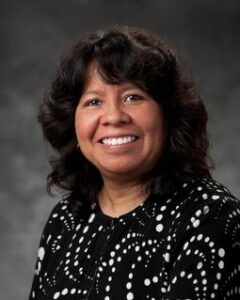 On 4/14/22 Prof. Lorena Rios Mendoza visited EPD 639, Plastics Recycling and Sustainability, to share her research and expertise in microplastics, especially the state of microplastics in the Great Lakes. Prof. Rios Mendoza has been faculty at UW Superior in the chemistry department since 2010. Prof. Rios Mendoza started her career concerned about environmental pollution, especially in bodies of water, and has been working with microplastics for over fifteen years. She currently works to track and identify microplastics in various bodies of water as well as the pollutants adsorbed onto the microparticles. One of her most important tools in identifying these materials is FTIR spectroscopy. She has identified microplastics from cosmetics, from clothing (including natural fibers such as cotton), and other sources. Most of the microplastics identified in Lake Superior (~80%) were from wastewater. Although Lake Superior is the cleanest of the Great Lakes, it is still possible to find any of a number of plastic or other pollutants in its waters, emphasizing the scale of the problem. Her work has also identified persistent organic pollutants such as phthalates, which are/have been often used as plasticizers. Other emerging pollutants of concern from consumer products or wastewater such as triclosan or even caffeine have also been identified. She has confirmed that microplastics do concentrate these pollutants by orders of magnitude. These microplastics and pollutants end up being ingested by a range of organisms and animals, concentrating up the food chain in a manner similar to the more familiar example of DDT. While this is of obvious concern, we still do not have a full grasp on the biological consequences of these materials circulating throughout our environment. One point that Prof. Rios Medoza emphasized was that so much still needs to be learned. Her group at UW Superior has also made efforts to pick up plastic waste from beaches along Lake Superior’s coast. We learned a great deal about the type and source of microplastics pollution in our lakes!
On 4/14/22 Prof. Lorena Rios Mendoza visited EPD 639, Plastics Recycling and Sustainability, to share her research and expertise in microplastics, especially the state of microplastics in the Great Lakes. Prof. Rios Mendoza has been faculty at UW Superior in the chemistry department since 2010. Prof. Rios Mendoza started her career concerned about environmental pollution, especially in bodies of water, and has been working with microplastics for over fifteen years. She currently works to track and identify microplastics in various bodies of water as well as the pollutants adsorbed onto the microparticles. One of her most important tools in identifying these materials is FTIR spectroscopy. She has identified microplastics from cosmetics, from clothing (including natural fibers such as cotton), and other sources. Most of the microplastics identified in Lake Superior (~80%) were from wastewater. Although Lake Superior is the cleanest of the Great Lakes, it is still possible to find any of a number of plastic or other pollutants in its waters, emphasizing the scale of the problem. Her work has also identified persistent organic pollutants such as phthalates, which are/have been often used as plasticizers. Other emerging pollutants of concern from consumer products or wastewater such as triclosan or even caffeine have also been identified. She has confirmed that microplastics do concentrate these pollutants by orders of magnitude. These microplastics and pollutants end up being ingested by a range of organisms and animals, concentrating up the food chain in a manner similar to the more familiar example of DDT. While this is of obvious concern, we still do not have a full grasp on the biological consequences of these materials circulating throughout our environment. One point that Prof. Rios Medoza emphasized was that so much still needs to be learned. Her group at UW Superior has also made efforts to pick up plastic waste from beaches along Lake Superior’s coast. We learned a great deal about the type and source of microplastics pollution in our lakes!